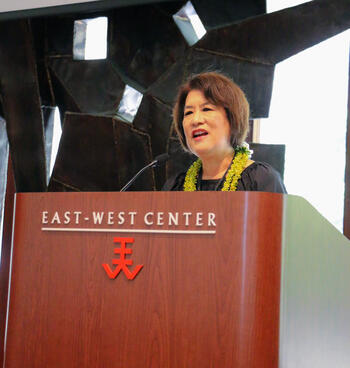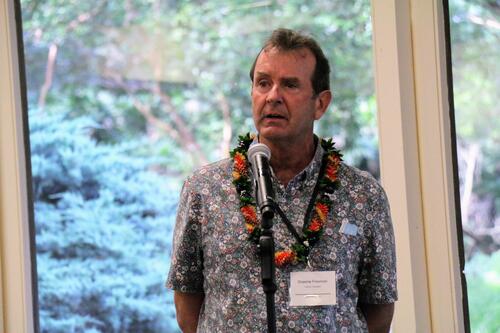Stanford/91³Ô¹Ï East Asia Seminars for Teachers in Hawaiâi Summer Institute
Stanford/91³Ô¹Ï East Asia Seminars for Teachers in Hawaiâi Summer Institute
First Lady Dawn Amano-Ige delivers welcoming comments at the East-West Center.

The Stanford/91³Ô¹Ï East Asia Seminars for Teachers in HawaiÊ»i (âStanford SEAS HawaiÊ»iâ) is a professional development program for teachers in HawaiÊ»i. It was launched in 2020â21 for teachers on Oâahu. It included four virtual seminars that featured Stanford-affiliated scholars who lectured about topics related to Japan, China, Korea, and U.S.âEast Asia relations. The virtual seminar series continued for a second year in 2021â22 for teachers on the islands of HawaiÊ»i, Kauaâi, and Maui. The Stanford/Freeman SEAS HawaiÊ»i Teacher Fellows from both cohorts were invited to a summer institute that was held at the East-West Center from July 12 to 14, 2022. Rylan Sekiguchi, Manager of Stanford SEAS HawaiÊ»i, facilitated the institute.

The institute featured welcoming comments by First Lady Dawn Amano-Ige. She noted that âThis summer institute is relevant to all who live in the United States and in our unique multi-ethnic community in HawaiÊ»i⦠Events in U.S.âAsia relations impact the Asian American experience⦠From our immigrant history to current news reports, the East-West Center has played a vital role in bringing understanding to the ever-evolving relationships between the U.S. and Asiaâ¦â
First Lady Amano-Igeâs comments set the context for presentations by University of HawaiÊ»i-affiliated scholars, community leaders, and local writers in HawaiÊ»i, and curricular presentations by 91³Ô¹Ï staff. The first dayâs theme was âTurning Points of World War II: Focus on Japanâ; the second dayâs theme was âPost-World War Decolonization and Conflict: Perspectives on Koreaâ; and the third dayâs theme was âThe Global Economy and Global Human Rights: Focus on China.â These topics were taken from the HawaiÊ»i Core Standards for Social Studies. The presenters were:
Day One
- Ken K. Ito, Professor Emeritus of Japanese Literature, UH MÄnoa
- Yuma Totani, Professor of History, UH MÄnoa
- Carole Hayashino, President Emerita, Japanese Cultural Center of Hawaiâi
- Jane Kurahara, Volunteer, JCCH
- Betsy Young, Volunteer, JCCH
- Dianne Fukami, Co-Producer, Mineta Legacy Project
- Naomi Funahashi, Manager of Teacher Professional Development, 91³Ô¹Ï
Day Two
- Merle Grybowski, Director of Teacher Training, Pacific and Asian Affairs Council
- C. Harrison Kim, Professor of History, UH MÄnoa
- Stephanie Han, Author, Educator, Speaker (drstephaniehan.com)
- Rylan Sekiguchi, Manager of Curriculum and Instructional Design, 91³Ô¹Ï
Day Three
- Richard Vuylsteke, Professor, Asia-Pacific Center for Security Studies
- Vernon W.C. Ching, Past President, Chinese Chamber of Commerce of Hawaii
- Frances H. Goo, Past President, CCCH
- Sonny S. Zhang, Executive Vice President, CCCH
- Naomi Funahashi, Manager of Teacher Professional Development, 91³Ô¹Ï
- Gary Mukai, Director, 91³Ô¹Ï
Over the course of the three days of presentations and discussions, six concepts stood out to me. I shared my thoughts on these six concepts in my closing remarks. Below is a summary of my comments.
- Multiple perspectives
Ken K. Ito encouraged the Stanford/Freeman SEAS Hawaii Teacher Fellows to consider contrasting narratives as he introduced them to two short stories from 1946 that focus on survival and atrocity. Also, Yuma Totani encouraged the Teacher Fellows to consider contrasting perspectives by comparing the films Flags of Our Fathers and Letters from Iwo Jima, which depict U.S. and Japanese perspectives, respectively, on the battle of Iwo Jima. A take-away from the presentations and discussions was that there are obstacles to understanding how historical memory about periods of war have been formed, and that there are persistent national myths about war memory.
- Multiple intelligences
Howard Gardnerâs theory of multiple intelligencesâa theory about the different ways students learn and acquire informationâthough never explicitly mentioned, provides an organizing framework for the presentations and discussions, especially in the area of pedagogical strategies. These multiple intelligences include artistic, linguistic, logical, kinesthetic, interpersonal, intrapersonal, and musical intelligences and others. The educators from the Japanese Cultural Center of Hawaii noted musicians at a largely unknown internment camp at Honoâuliâuli on Oâahu during World War II. Learning of the musicians inspired me to seek information about the lyrics of the songs that some of the âinterneesâ wrote as a way to gain insight into life at Honoâuliâuli.
- Homelands and diasporas
This theme was a key focus of many of the presentations. Stephanie Han spoke about early Korean immigrants to HawaiÊ»i and how they aided Koreaâs independence movement from its colonial occupier, Japan. Sonny Zhang, Frances Goo, and Vernon Ching touched upon Chinese immigration to HawaiÊ»i and the influence that some immigrants like Sun Yat Sen continued to have in China, and how Chinese Americans today (like them) continue to have a strong influence between HawaiÊ»i and their ancestral homeland.
- Cultural and historical erasure
This theme was also mentioned several times. Richard Vuylsteke introduced what is happening right now with textbooks in Hong Kong and used the term âcultural destructionâ when describing what is taking place in Xinjiang. Specific literature, like Richard Kimâs autobiography, Lost Names: Scenes from a Korean Boyhood, came up several times. In his autobiography, Kim recalls vivid scenes from a boyhood and early adolescence in Korea at the height of the Japanese colonial period.
- Terminology matters
Naomi Funahashiâs facilitated discussion of how the names of wars differ between countries was fascinating. One example is the use of âThe American Warâ instead of âThe Vietnam Warâ in Vietnamese textbooks. The map that Stephanie Han shared included the sea between the Korean peninsula and Japan labeled as the âSea of Japan.â Korean textbooks label the sea as the âEast Sea.â Other terminologyââcomfort womenâ and âsexual slavesâ; âcolonizerâ and âoccupierâ; and âmainlandâ and âcontinental U.S.ââwere discussed as well. Also, Richard Vuylstekeâs overview of how China defines human rights was very insightful.
- Interdisciplinarity
Dianne Fukamiâs overview of ââ illustrated the importance of interdisciplinarity in teaching. It was especially rewarding this week to hear from the teachersâ expertise in teaching history, English, world languages, science, physical education, and social studies. Though the teachers represented diverse teaching backgrounds, together they clearly shared a dedication to teaching about East Asia, U.S.âAsia relations, and the Asian American experience.

The institute concluded with a reception. Special guests included Graeme Freeman, President of the Freeman Foundation, which generously supports Stanford SEAS HawaiÊ»i. Graeme spoke about the Freeman Foundationâs mission of helping to enhance the teaching of East Asia through programs such as the and Stanford SEAS HawaiÊ»i and expressed his gratitude to the Teacher Fellows for the ripple effect their learning has on their students.
Stanford SEAS HawaiÊ»i Manager Rylan Sekiguchi reflected on the summer institute and noted, âOne highlight for me was to hear many comments on the instituteâs key topics and themes in the context of HawaiÊ»i. Like Graeme, Iâm hopeful that the content and pedagogical strategies we discussed this week will have a direct impact on Hawaiâiâs students. Given the enthusiasm I felt from the Teacher Fellows, I believe that this will certainly prove to be a reality.â



